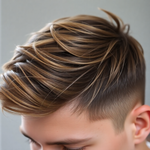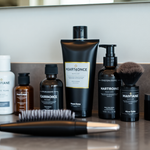
Use Semi-Permanent Hair Color to Cut Clothing Waste — Practical Steps to Build a Sustainable Men's Capsule Wardrobe
23 September 2025
Share
Use Semi-Permanent Hair Color to Cut Clothing Waste — Practical Steps to Build a Sustainable Men's Capsule Wardrobe
Struggling to look sharp without buying more clothes? Use semi-permanent hair color to cut clothing waste by changing how your existing pieces read against your hair—so fewer impulse buys, cleaner outfits, and a smarter wardrobe. This guide shows step-by-step how a small grooming tweak pairs with capsule thinking to save money, time, and the planet while keeping your look intentional and masculine.
Why this approach works
People buy clothes to solve a mismatch problem: a shirt doesn’t look right, or a jacket doesn’t pop. Often the fix isn’t another garment—it’s adjusting the frame around it. Hair color influences perceived contrast, warmth, and overall harmony. A subtle tone shift can make the same shirt pair better with multiple trousers and jackets. When your head and clothes read as a cohesive system, you stop buying to compensate.
Key benefits at a glance
- Reduce clothing turnover and textile waste by making what you own feel new.
- Save money—semi-permanent dyes are affordable and low-commitment compared with full recolors or constant shopping.
- Flexible style—experiment with warmth or coolness to change how colors work together without changing cuts.
- Quick wins—apply at home or get a short salon visit; results last through several washes so you can assess and adapt.
How semi-permanent hair color actually changes wardrobe perception
Semi-permanent dyes sit on the hair shaft and wash out gradually. That means you can try a warmer or cooler tone for a season, see how it pairs with your capsule, and revert if you don’t like it. A warmer hair tone increases the harmony with warm neutrals (tan, olive, camel), while cool tones sharpen contrasts with cool neutrals (navy, charcoal, slate). The result: your existing garments look intentional and cohesive.
Pick your capsule strategy first
Before you touch color, decide on a 3+1 palette. This is the backbone of every effective capsule wardrobe.
- 3 neutrals: pick three base colors (e.g., navy, charcoal, tan).
- 1 accent: choose an accent color (e.g., forest green, burgundy, rust) used sparingly for visual interest.
- Texture and fit: add texture (knit, twill, suede) and prioritize fit over trend.
Write the palette down and photograph your favorite outfits. These references guide your hair choice so dye decisions solve real pairing problems—not whims.
Use Semi-Permanent Hair Color to Cut Clothing Waste — step-by-step plan
This is the core action plan: practical, sequential, and easy to follow.
- Week 1 — Closet audit: Empty your wardrobe, divide into keep, repair, donate, and sell piles. Photograph outfits you wear most. Identify gaps by style need, not by impulse.
- Week 2 — Choose a capsule palette: Pick your 3+1 colors. Note which pieces belong to each color bucket.
- Week 3 — Color planning: Compare your palette to your natural hair tone. Decide whether a slight warm or cool shift would increase outfit matches. If in doubt, aim for subtlety: one level warmer or cooler.
- Week 4 — Test and apply: Do a strand test with a semi-permanent product. If it reads right after a week, do a full application at home or book a short salon session.
- Month 2–3 — Monitor and refine: Track outfits for 4–6 weeks. Note items you reach for more. If the change didn’t improve cohesion, let the dye fade and try the opposite direction or a different level.
Choosing the right semi-permanent shade
Shade selection is simple when you connect it to your capsule:
- Warm palettes (tan, camel, olive, rust): aim for subtle warm tones—dark honey, warm chestnut, or soft golden brown. These boost harmony with warm neutrals.
- Cool palettes (navy, charcoal, slate): choose cool ash browns, espresso, or very dark cool tones that increase contrast with cool neutrals.
- High-contrast wardrobes: If you wear a lot of black-and-white, minor cool shades or a strong neutral black-brown keep the contrast crisp without looking washed out.
At-home application: safe, effective, and low-waste
If you opt to do it at home, follow these steps to minimize mistakes and waste:
- Select a low-impact formula: Look for ammonia-free and low-peroxide semi-permanent dyes packaged in recyclable materials where possible.
- Do a patch test: Apply to skin behind your ear 48 hours before full use to check for allergic reactions.
- Strand test: Test a small section near the nape to preview how the shade interacts with your natural tone.
- Prep: Wear gloves, protect surfaces with an old towel, and use a bowl and brush for controlled application. Avoid running dye down the sink—dispose of rinses on absorbent paper you can compost or trash, rather than rinsing directly into drains when possible.
- Apply and time: Follow product timing closely—overdevelopment can push the tone too far.
- Rinse and condition: Rinse until water runs clear and use the conditioner provided or a color-safe conditioner to lock in tone.
Salon vs home: which is right for you?
- Salon pros: A stylist can tailor tone precisely, give advice on how hair and wardrobe interact, and perform quick corrections. Good for men who want a targeted result and are willing to invest a short session.
- Home pros: Cost-effective, private, and easy to manage for subtle changes. Best if you’re aiming for one- or two-level tweaks and comfortable following instructions.
Color maintenance that supports sustainability
- Wash less and cooler—this preserves both hair color and clothes.
- Use sulfate-free, color-safe shampoos.
- Condition regularly to reduce dryness and breakage—healthier hair holds color better and looks better with clothes.
- Delay major color changes—incremental adjustments reduce chemicals and product turnover.
Outfit examples and pairings (real-world combos)
Here are practical pairings to try after a small warm or cool hair shift. Each combo uses capsule logic so you rely on fewer items more often.
- Warm hair tweak — Office casual: Tan chinos + navy overshirt + white tee + brown derby. Warm hair tone softens the tan/navy combo and makes leather accents feel cohesive.
- Cool hair tweak — Weekend sharp: Charcoal jeans + slate henley + navy bomber + clean white sneaker. Cool hair keeps the palette crisp and increases perceived contrast of dark neutrals.
- High contrast — Date night: Black denim + white oxford + charcoal blazer + black boots. A neutral dark hair tone keeps the monochrome look sharp without appearing washed.
Cost and environmental comparison: shopping vs grooming
Buying a new jacket or pair of trousers to "fix" a color mismatch usually costs far more than a bottle of semi-permanent dye plus a conditioner. More importantly, the environmental cost of producing a new garment—textile production, shipping, packaging—is substantially higher than a single low-impact grooming change. For facts on textile waste and sustainable handling, see the EPA's overview on sustainable materials management for textiles: epa.gov/textiles.
Repair, reuse, and rotate: minimize waste with maintenance
Even the best capsule wears down. Repair extends life:
- Learn basic stitch and button replacement.
- Keep a small kit at home for minor repairs.
- Use resoling and cobbler services for shoes.
- Reshape and refresh coats with steam and professional pressing rather than replacing them.
Tracking impact: simple metrics to measure progress
Keep this in a notes app or notebook:
- Number of items bought monthly (goal: down 50% vs prior year).
- Items repaired vs replaced.
- Outfit repeat rate—how many unique outfits you actually wear each week.
- Perceived cohesion score—rate how intentional your outfits feel on a 1–5 scale weekly.
Case study: Tom's 6-month capsule experiment
Tom, 29, worked in tech and had a closet full of single-use items. He chose a navy/charcoal/tan palette with rust accent. After a subtle warm chestnut semi-permanent treatment, he found: more use from olive shirts, fewer impulse buys, and two jackets he previously avoided now worked with his hair tone. He sold five items and saved the cash for a high-quality outerwear piece. Results: less clutter, better fit, and a more consistent look. Small grooming action + capsule rules = long-term change.
FAQs
- Will semi-permanent dye damage my hair? Minimal when used correctly. Semi-permanent formulas don’t penetrate like permanent dyes and generally cause less damage. Use conditioning and avoid overlapping too frequently.
- How often will I need touch-ups? It depends on hair porosity and the product, but expect the tone to last 4–12 washes. If you’re maintaining a subtle shift, reapply every 4–8 weeks.
- Can I switch back if I don’t like it? Yes—semi-permanent fades naturally. You can also counter with a cool/warm shade to neutralize faster, but patience is usually the cleanest method.
- Is this only for certain ages? No—this strategy works for men 18–45 and beyond. The goal is cohesion, not youth or trendiness.
Visual and accessibility guidance
Suggested images: a flat-lay of a capsule outfit next to a small semi-permanent kit; a side-by-side comparison of cool vs warm hair tones with the same outfit; an infographic showing the 3+1 palette system.
Alt text examples:
- "Flat-lay capsule wardrobe on wooden floor with semi-permanent hair color kit"
- "Before and after hair tone comparison with navy jacket and tan trousers"
- "Infographic: 3+1 capsule palette and outfit combos"
Internal and external resources
For capsule-ready outerwear and sustainably-made outer layers, check Menll.com’s outerwear collection: menll.com/collections/outerwear. For a versatile everyday shoe with eco-minded materials, consider Menll.com’s EcoSneak Casual Shoes as a practical choice that pairs with most capsule looks.
External resources for safety and sustainability: WebMD on hair dye risks—webmd.com/hair-dye-risks; EPA on textile sustainability—epa.gov/textiles.
Checklist: your 30-day starter plan
- Audit your closet this weekend.
- Define your 3+1 palette.
- Buy one small semi-permanent dye (low-impact formula) for a strand test.
- Try a single subtle shift and photograph outfits for two weeks.
- Decide whether to keep the change, adjust, or fade back.
Common mistakes and how to avoid them
- Buying new clothes before testing a color change—test first.
- Going extreme on the first try—aim for subtlety (1–2 levels).
- Neglecting repairs—small fixes extend garment life more than new purchases.
Long-term mindset: grooming as a sustainability tool
Think of grooming choices—hair, beard, and skin—as levers you can pull to make your wardrobe work harder. A small, reversible hair tweak can be the difference between a closet that feels chaotic and one that feels curated. Over time, consistent capsule practices plus intentional grooming reduce consumption and increase confidence.
Final takeaways
- Use semi-permanent hair color to cut clothing waste by improving outfit cohesion and extending garment usefulness.
- Pair hair tweaks with a 3+1 capsule system to minimize purchases and maximize outfit combinations.
- Start small, test, and track impact—repair more, buy less, and choose quality when you do purchase.
Want to get practical right now? Audit one week's outfits, pick your 3+1 palette, then try a subtle semi-permanent shade to see how many pieces work better together. Browse Menll.com’s outerwear collection to find capsule-ready jackets that pair well with both warm and cool hair tones: menll.com/collections/outerwear.
Which hair tweak will you try first to make your wardrobe work smarter? Share your plan in the comments or tag a mate who needs these tips.
SEO meta
Meta Title: Use Semi-Permanent Hair Color to Cut Clothing Waste — Sustainable Men's Capsule Wardrobe
Meta Description: Learn how to use semi-permanent hair color to cut clothing waste and build a practical, sustainable men's capsule wardrobe with step-by-step, actionable guidance.
Prev post
Next post

Dye to Declutter: How Semi‑Permanent Hair Color Can Streamline Your Sustainable Men's Capsule Wardrobe
Updated on 22 September 2025






